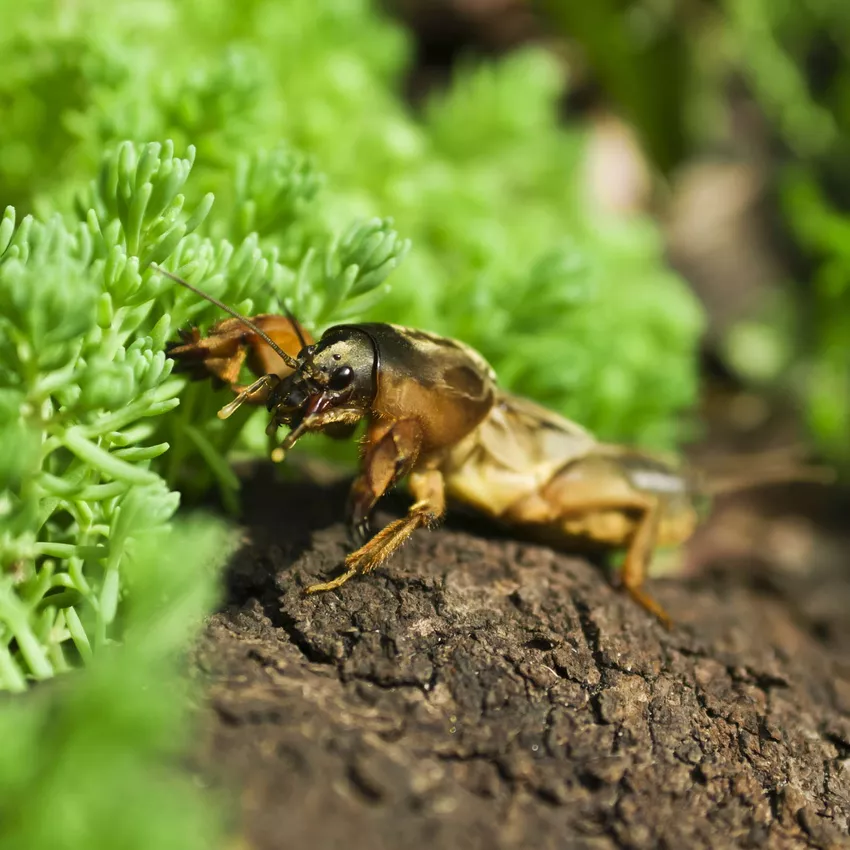Mole crickets are rarely seen, but they can be quite a nuisance to plants. Find out how to recognize & fight them here.

Although the mole cricket (Gryllotalpa gryllotalpa) is in declining numbers and is now an endangered species, it can be quite damaging in some gardens. Tunnels in the ground, wilted plants and rough feeding on root vegetables are suspicious signs of mole cricket infestation. Here you can find out whether your suspicions can be confirmed and how you can combat the annoying little animals in the garden.
Mole Cricket: Profile
The European mole cricket (Gryllotalpa gryllotalpa) is also called "Werre" and belongs to the order of grasshoppers (Orthoptera). Even if it may not seem like it to people with an infested garden: the mole cricket is actually only found very rarely and is one of the endangered species. It is most common in the southwestern part of Germany. With its stately size of about 5 cm and the mole-like digging legs, the mole cricket is one of the more conspicuous garden dwellers. The insects are brownish-black and nocturnal. Although the animals mainly feed on pests and other animals such as earthworms, they can still cause considerable damage in the garden. Because mole crickets dig finger-thick passages in the ground with their front legs, which are reminiscent of shovels, and often destroy plant roots in the process. They also like to nibble on roots, tubers and other plant parts close to the ground.

Mole Cricket Larva
Mole crickets mate in April or May. The female then lays up to 300 eggs in a brood hole about the size of a fist. The development of the larvae can take up to three years. During this time, the animals go through several larval stages. That is why you can sometimes find lighter young larvae, older dark larvae and adult crickets in the soil at the same time.
Recognizing mole crickets: What are theyDamage?
In the spring, wilting young plants and seedlings as well as dying plant parts are typical signs of digging or feeding damage to the roots by adult mole crickets. There may be bare patches in the lawn. In addition, feeding spots on tubers or turnips can be an indication that the mole cricket was active. Unfortunately, although most damage occurs to vegetables, ornamental plants are not spared either.

Fighting mole crickets
Even though the mole cricket is an endangered species, it can cause a lot of damage and disruption in the garden. There are of course differences between a few spotted crickets and an affected plant and an almost invasive infestation where the mole cricket lives up to its name. In the first case, one should think about species protection and trust that the natural enemies of the mole cricket, including shrews, moles and larger birds such as starlings or crows, will regulate their occurrence quite naturally. In the second case, when half the vegetable patch is wilting and most of the root vegetables have been eaten, there are several options for biological pest control that work quite well in most cases. Since mole crickets also eat many other pests as beneficial insects, you also benefit from fighting the little creatures only in the case of a large infestation and serious damage.

Catching mole crickets with traps
At night, the mole crickets move on the ground surface. They can therefore be easily caught with cans or preserving jars (diameter about 10 cm) buried at ground level. No attractant has to be put in the trap. The traps only work because the mole crickets fall into the jar or can on their nocturnal foray through the garden and never come out. Star-shaped wooden slats running towards the trap make the path into the trap a little more hopeless for the crickets. Because all other sometimes useful garden dwellers are also caught in the traps, it is worth checking the traps frequently and freeing beneficial insects that are not able to fly. This control method is particularly recommended because the caught mole crickets are released in the interest of species protection in a meadow in the open countrysidecan.
Fighting mole crickets with nematodes
Another way to combat mole crickets biologically is to use natural antagonists. The nematode species Steinernema carpocasae , which also includes our Plantura SC nematodes, particularly likes the larvae of the mole cricket. The nematodes, also called roundworms or nematodes, are sold in a powder. Mix the powder with water according to the enclosed instructions and pour the mixture out with the watering can. SC nematodes against mole crickets are applied between March and July when the soil temperature is at least 12°C. The nematode broth is best distributed in the morning or evening, because the small animals do not like UV radiation. After application, the nematodes actively seek out and parasitize the larvae of the mole cricket. The use of Steinernema carpocasae-nematodes as natural enemies of mole crickets is extremely effective when handled correctly and at the right time.
You can find more information about the use of nematodes as beneficial pest control insects in the garden here.
Fight mole crickets with slug pellets?
Slug pellets are generally not recommended in the vegetable garden. Since there are good and efficient ways to biologically control mole crickets, these options should be resorted to.
Many a pest infestation in the garden can also be counteracted with home remedies. We have put together some home remedies for pest control for you.